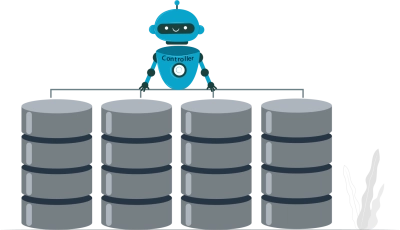What is a RAID Controller?

You can’t set up a RAID level without a RAID controller; you can either use a hardware controller or a software controller. RAID controllers are the “main thing” in RAID setups. Your controller plays a huge role in determining the performance of the RAID array. This article explains how RAID controllers work, and how you can make a perfect choice between hardware or software controllers.
What Are the Advantages of RAID Controllers?
The advantages of using a controller depend on the type you choose. A software controller can save you the cost of purchasing additional hardware but might not offer the same performance speed as a hardware controller.
People who use software controllers typically have high-performance systems, so running a RAID using the system’s software won't significantly impact the computer’s processing power. Additionally, the type of controller you select influences the RAID level you can implement. Overall, controllers improve data redundancy, performance, and system uptime in RAID storage, enhancing the reliability and efficiency of your storage solutions.
What Exactly is a RAID Controller?
What is a RAID? To put it in clear terms, a controller is a hardware device or software program for setting up and managing RAID levels. A RAID controller works by combining two or more HDDs or SSDs to function as one logical storage array.
Provide a clear and concise definition of a controller, explaining its purpose and key features. Include information on how it manages the array of disks to distribute data and parity information.
What Does a RAID Controller Do?
A controller is a mediator (could be a software program or a hardware) that fosters communication between an operating system (OS) and an array of physical drives. A RAID controller makes an OS view a set of connected drives as a single logical volume for data storage.
Also, a control can read multiple hard drives at a go, and as such, it can offer improved read and write speeds, as well as secure data on the drives for a limited time in the case of a system crash or drive failure. But, even though RAID levels – through the help of a controller – can offer some level of data redundancy, they should not be used as a total replacement for backups.
Depending on the RAID controller you got, you can set up data striping, mirroring, or parity by configuring a RAID level that supports any or two of these features. In total, there are about 10 different RAID levels, and some of these RAID levels have variations. You can only create a RAID level supported by your controller – whether a software or hardware controller.
How to Check Your RAID Controller

If you’re considering setting up a software RAID, you have to first check if your PC has support for such configurations. Well, if your system does not have built-in RAID support, you can always install a RAID controller card or get a standalone hardware version. To check if your PC has a built-in RAID controller, follow the steps below;
- Right-click on Start and select Device Management
- Expand the Storage Controllers tab and there you can see the controllers built into your PC; if you don’t find the Storage Controllers open, your PC probably doesn’t come with RAID controllers built-in.
If you custom install a software RAID controller, you may need to also install a software program to check the status of the controller. You can also check if your system has a built-in RAID controller via the BIOS;
- Reboot the computer and enter the BIOS mode by pressing F12, ESC, or F10, depending on your PC model
- Go to Device Configuration, if your motherboard supports RAID configuration, you should see RAID settings in this menu.
Another way to check if your PC supports built-in RAID configuration is via the CLI utility. This involves running a few commands to view your PC’s storage details:
- Launch the CLI utility as admin and run the diskpart command
- Diskpart 🡺 lis dis 🡺 sel dis # (replace # with your disk letter/number) 🡺 det dis
- This will show you details about your disk.
Hardware VS Software RAID Controllers

You’re either running software RAID or hardware RAID; what identifies the RAID type you’re running is the controller that handles the operations. If you’re using an external controller, then you’re running hardware RAID, and if you’re using your motherboard’s built-in controller, then it’s a software RAID. Generally, setting up hardware RAID is more expensive because of the additional hardware.
Hardware-Based RAID Controller
What are RAID cards? What does a RAID card do? Hardware controllers, also called RAID adapters, are physical devices capable of setting up specific RAID levels. These devices can come as a Peripheral Component Interconnect (PCI), or Peripheral Component Interconnect Express (PCIe) card.
A hardware controller may support Serial Advanced Technology Attachment (SATA) or Small Computer System Interface (SCSI) drive format, and some of them can be integrated with the motherboard of a system. Popular manufacturers of hardware RAID controllers include Broadcom, Intel, Microsemi Adaptec, Dell, IBM, and Cisco.
In general, hardware controllers can function alone without drawing support from the host system’s CPU or DRAM; thus, they are the most preferred choice for (enterprise) data environments where high performance and speed are required.
But, not all hardware RAID adapters may be compatible with your system’s OS version. So, it’s advisable to always check for compatibility and other features such as interface connectivity when buying a controller. Other features you may want to check out are:
- RAID levels supported
- Encryption capabilities
- Highest number of drives that can be connected
- Read/write performance
- Power rating
- Operations per second rating
- Cache size
Pros:
- Faster performance speeds
- Usually supports more RAID-level configurations than software RAID
- Easier to rebuild or replace failed drives when you use a RAID hardware controller
- Doesn’t necessarily require a high-specced computer
Cons:
- Costs more to set up, since you have to buy additional hardware – the controller/adapter, and some of these adapters cost above $500. There are affordable ones below $70 anyway.
Software-Based (Server-Based) RAID
Let’s say the software-RAID controller is the opposite of hardware adapters. These software- or server-based controllers are preinstalled on your system or server. A software controller relies on the host system’s hardware resources to function, such as the motherboard, CPU, and DRAM.
If your system doesn’t come with a software controller preinstalled, then you should use a hardware RAID card because your system’s specs can’t handle the additional stress imposed by built-in controllers.
Apparently, software controllers deliver the same functions as RAID controller cards; the only difference is, that the former uses its host system’s hardware while the latter uses its own hardware. Also, built-in controllers may support only a few RAID-level configurations.
Pros:
- Cost-effective to setup
- More flexible and customizable
- Third-party software RAID can be implemented (SnapRAID, SoftRAID, or StableBit DrivePool).
Cons:
- Supports limited RAID levels
- Might slow down your PC’s performance due to additional stress on the CPU and DRAM
- Requires a high-specced computer
Which is Better?
Both software and hardware RAID setups have their advantages and disadvantages. If you want to save cost and have a high-specced system, then setting up software RAID could be the best for you. On the other hand, if your PC isn’t high-specced and doesn’t come with a built-in controller, it’d be much better to spend on a hardware controller and set up your RAID level.
Some operating systems like Windows Server come standard with an integrated controller software (Storage Spaces). Similarly, some enterprise Linux distros allow you to run software-based RAID via the mdadm utility.
Conclusion
A RAID controller is simply the platform on which you can build a RAID level; the RAID level you may be able to set up is largely dependent on your controller. Both software and hardware RAID can deliver optimal performance; however, because hardware RAID doesn’t utilize the host system’s resources, it tends to offer much better speed and performance.
RAID controllers help to protect data saved on your RAID drives in the event of data loss or drive failure – but there’s a limit to which a controller can hold on to parity data. RAID storage is used in different settings, including home data storage and in enterprise environments.
When you set up a RAID level, you may need third-party software to monitor the array and view detailed information on how the RAID is performing. Recover RAID using DiskInternals RAID free raid recovery software.
FAQ
- What is RAID and what is it used for?
RAID, standing for Redundant Array of Independent Disks, refers to a storage technology that distributes data across several drives in a single system. This technique employs various configurations, denoted by numbers like RAID 0, RAID 1, or RAID 5, to achieve different levels of performance, redundancy, and storage efficiency.
- What is the difference between RAID controller and SAS controller?
SAS Controller: A device that links SAS drives with a computer system, facilitating communication between them. The distinction between a RAID setup and a SAS controller is rooted in their roles and functions within a computer. While RAID (Redundant Array of Independent Disks) is a technology designed to merge several physical disks into one logical unit for improved redundancy and performance, a SAS controller primarily serves as the conduit for connecting SAS drives to the system.
- Is it necessary to have a RAID controller?
A RAID controller is key for securing data redundancy, ensuring fault tolerance, and enhancing storage efficiency. It significantly contributes to spreading data over various drives within RAID arrays, safeguarding continuous data accessibility despite the failure of one or several drives.
- What is the purpose of a RAID card?
A RAID controller serves two main purposes: first, to merge several slower or smaller storage devices into a unified, faster, and larger volume drive operating as one logical unit; and second, to establish redundancy to maintain data accessibility and integrity in case of a drive malfunction.
- Do I need a RAID card for RAID?
For other RAID configurations, which may involve striping data at the bit or byte level along with duplication, it is typically advised to use a dedicated controller. This approach guarantees correct implementation and provides finer control over the setup and ongoing management of the array.
